Cross-platform GUI Toolkit Trainwreck — 2016 Edition
Ok, I’m not too sure in what direction this post will go, an informative article, a rant, or both. Probably a bit of both, with an emphasis on the rant part, given my current not-quite-positive emotional involvement with the topic. Gentlemen (and gentlewomen), please fasten your seatbelts!
UPDATE #1: It turned out to be a quite informative mega-post in the end, just don’t give up reading after the first section…
UPDATE #2: There’s some very interesting alternative UI framework recommendations in the comments that I haven’t discussed in the article, so you might want to check those out as well…
Table of contents
Buttons and pixels
In 2016, developing a program in entirety on one particular platform, for example OS X, and then successfully compiling and running it on another, say Windows, with zero or minimal modifications required is no longer an utopistic dream. In fact, users of dynamic, interpreted or scripting languages (however you like to call them today) have been enjoying the luxuries of easy cross-platform development for many decades now; they won’t even raise an eyebrow on such trivial matters. But even the lowly C and C++ plebs are able to perform this feat with relative ease nowadays—at least, if they stuck to their respective language standards religiously and turned their compiler warnings up to nuclear-strength…
Being able to use a single codebase for multi-platform applications is of crucial importance. After all, who wants to maintain two or three (or more) codebases that are mostly similar, but not quite? I sure don’t. And then there’s the convenience and flexibility factor too: you can happily develop on your Linux VM on your desktop PC at home, then maybe fix some bugs on your MacBook while sitting on the train, with the confidence that your program will work flawlessly on Windows too. Not having to deal with platform differences and idiosyncrasies takes a huge burden off of the developer’s shoulder that is not to be underestimated.
Some compiled languages, like Nim, give you such cross-platform guarantees by design. This is all good, this is all well, this is precisely how things should be. The world is such a wonderful place, after all. Write once, run anywhere (and don’t go near the JVM). Excellent! The universe is smiling at you. Infinity co creates karmic balance. Freedom unfolds into intrinsic actions. Your consciousness manifests through quantum reality. 1
Except for one little thing. You must not under any circumstance try to open a window (on the computer, I mean), attempt to change the colour of a single pixel in it, or—god forbid!—fantasise about using native (or any kind of, for the matter) GUI controls in a cross-platform and non-hair loss inducing manner! If you disregarded my sage advice and foolishly ventured to accomplish any of the above tasks, the bliss would be over in an instant and you’d find yourself rudely transported back to the early days of computing, where making anything just barely work at all on different OSs would take inordinate amounts of time and effort!
Solution to a problem
I’m not just talking in the abstract here, I am merely describing my trials and tribulations when attempting to extend my ray tracer I’m developing in Nim with a very minimalistic GUI. My ambitions were fairly modest: I only wanted to open a window and then split it into a canvas and a control area. Onto the canvas I would just blit some pixel data periodically and the control area would contain some buttons and some static text (maybe a progress bar too if I felt particularly bold and adventurous!). I wanted this fine piece of software craftsmanship to work on Windows, Linux and OS X, without having to write any platform specific code. And that’s it!
So next step, let’s investigate what cross-platform libraries are available for Nim!
IUP
I was looking for something really minimal and I would have perfectly been happy with native controls, so the Nim bindings to the IUP GUI library (a cross-platform toolkit in C for creating GUI applications in Lua) looked very promising… until I found out that it does not support OS X at all. Oh well.
GTK2
The next obvious candidate was the GTK2 bindings for Nim. I am not a fan of GTK on Windows at all, and especially not on OS X (despite the fact that I really love Inkscape on Windows, but let’s just write that off as an anomaly). Anyway, why not give it shot, it doesn’t cost any money. Well, after having spent about half an hour foraging on the Internet for the GTK2 Windows binaries (because the official GTK+ Project website is of not much help at all in that regard, apart from some kinda vague instructions on where to try to locate them), the poor directory containing my ~300K executable got suddenly about 20 megabytes bigger (!) in the form of the cheerful company of 10+ DLL files. The thing surely worked just fine (to the extent that GTK2 is capable of doing so), but this is a very bad start already as I wanted something small that can be statically linked. Adding 20 MB fat to my cute little 300K renderer is an idea that I find quite obscene to be honest (as in “obscenely obese”), so in short, no thanks.
Executive summary: GTK2 + non-Linux platform = AVOID
Some people might feel the urge to point out now that I’m way too picky, this is merely a solution to a problem, it works, so I should just suck it up and live with the over 60-fold increase of my total binary size! Well, this is a solution to a problem too:

And with that move, I had practically exhausted all the readily available GUI options for Nim. (Note that this is not a rant against Nim at all; I absolutely love that language, (in fact, it’s my favourite language at the moment); it’s not Nim’s fault that most—if not all—cross platform GUI toolkits suck in one way or another (having been written in C++ is one major source of such suckage)). 2
At this point, the needle of my stress-o-meter was already hovering in the orange zone. Luckily enough, I then found something interesting…
IMGUI to the rescue
I haven’t heard about immediate mode UIs (IMGUI) before, so in my initial excitement I thought this could be the answer to all my woes. For anyone not familiar with the concept, the general idea is that with an IMGUI the UI does not live in memory and manage it’s own state, as it is the case with traditional retained mode GUIs (RMGUI), but it gets “recreated” and redrawn on the fly on every frame at 60 FPS (or whatever your framerate is). From an implementation perspective, an IMGUI essentially boils down to one function per widget type, where that single function performs all duties related to the correct functioning of that particular widget (event handling, drawing, reporting the current state etc.) The construction of an IMGUI based UI thus becomes a series of simple function calls which makes it an attractive option from a simplicity and iteration speed standpoint. Also, because the whole interface gets fully redrawn on every frame, there’s no messing with dirty regions at all—just redraw the whole thing into an off-screen buffer, overlay it onto the top of the current frame and job done. Easy!
It turns out that while such an approach makes a lot of sense for a game that needs to redraw the whole screen at a constant framerate anyway, it’s not that great of a choice for a traditional desktop application where such frequent redraws would be wasteful.
(At least, that was my simplistic understanding of the whole IMGUI concept, which is not quite true, but I’ll just leave the above description here unaltered, as by judging by some of the threads on the topic, most people seem to misinterpret the concept of IMGUI in a very similar way like I did when I was just getting acquainted with it. So if you fully agree with the above two paragraphs, you’re wrong! :) What I described above is one particular way to implement an IMGUI that is very well suited to applications that need to redraw the screen at a constant frame rate anyway, generally using accelerated graphics (read, games). But the actual definition of IMGUI is much simpler: the UI is just a function of the current application state, thus the application is not responsible for explicitly managing the UI state and keeping it in sync with the app.)
Enter NanoVG
Ok, so my idea was to build a simple IMGUI user interface myself with NanoVG, which is a 2D vector graphics library that uses OpenGL as its rendering backend. The plan was to use it in conjunction with GLFW to shield me from any platform specific drawing and window handling stuff. That part actually worked out quite nicely; after a few days of hacking I had a window showing a bitmap image which was periodically updated from the internal render framebuffer with some GUI elements laid on top of it with transparency and whatnot.
So far so good, cross-platform custom GUI proof-of-concept check, but I suddenly found myself facing two brand new problems:
The constant redrawing of the whole UI on every frame was burning too much processor time, about 10-15% of CPU on my Intel Core i7 4790k 4.0 GHz (8 logical cores). That means 1 core out of the total 8 was constantly running at almost 100%!
The text rendering quality of NanoVG made me really depressed…
Exit NanoVG
The first problem was easy to fix. The abysmal performance had nothing to do
with NanoVG or OpenGL, it was caused by the constant redrawing at 60 FPS. The
solution was to redraw only when needed: as a quick hack I introduced a global
boolean doRedraw and set it to true only when an input event was received or
the internal application state had been changed (e.g. the framebuffer had been
updated). Then the drawing would only happen when doRedraw was set to true.
Surely this could be done in a nicer way, but the general concept would be the
same.
The second issue with text rendering was a harder nut to crack. NanoVG uses
the tiny
stb_truetype
single-header C font rasterizer to create the font atlases used for text
output. This is all well, but the quality at small font sizes is not that
great at all (not great enough to annoy the hell out of me). NanoVG seems to
have optional support for FreeType, but even if that works, it has only quite
rudimentary support for handling text layouts (which is quite buggy, by the
way). I really have zero inclination to neither start hacking the C code, nor
come up with my own font layout engine… I know there’s stuff like
Pango and
HarfBuzz, but I really
don’t want to do a Donald E.
Knuth
here and spend too much time on a problem that has already been solved on the
OS graphics library level in a perfectly satisfactory manner. I just want to
call drawText() and be done with it!
Alright, so OpenGL—and thus NanoVG—is not the way to go because of this whole text rendering fiasco… At this point, the progress of my adventures in the wonderful realm of cross-platform graphical user interfaces could be visualised pretty much spot on as follows:

State of the art
Ok, after putting the problem aside for a few days (mainly in order to calm down), I realised that the best way to go about this is to take a few quality cross-platform applications that I know well and analyse how they solved the custom GUI problem. So that’s exactly what I did next.
I have included a mini-breakdown for each app on the sizes of their various components (e.g. main executable, libraries, additional resources etc.), in an attempt to get a feel for what is considered acceptable in 2016. I used the 64-bit Windows versions except where noted otherwise.
REAPER
| Version | 5.12 |
| Main executable | 11 MiB |
| Resources | 23 MiB |
| Plugins | 30 MiB |
| Total install size | 68 MiB |
REAPER is a highly advanced cross-platform digital audio production workstation (DAW) for Windows and Mac OS X originally developed by Justin Frankel, the guy who wrote the original WinAmp. REAPER is written in C++ and it uses the open-source WDL library (from the same developer) for cross-platform graphics, audio and UI tasks.
It is a very much no-bullshit app, just look at the 11 MiB executable size! By examining the WDL sources it becomes pretty clear that REAPER uses a mixture of native software rendering (GDI on Windows, because it still supports XP) and an anti-aliased software rasterizer. The GUI is skinnable but non-scalable as the skins are completely bitmap based, so a good proportion of the GUI drawing consists of blitting operations, presumably. There are some font rendering differences between the OS X and Windows versions that suggests that the app uses OS native text rendering under the hood. The menu bar and all dialog windows (e.g. file dialogs, preferences) are OS-native too.
It is evident that REAPER’s strategy in terms of the UI is to use as much OS provided functionality as possible and resort to custom code only when necessary.
Update 2017-03-17: Justin, the man himself has enlightened me in the comments below that the situation is a bit more complicated than what I thought (quoted verbatim):
It’s worth noting that REAPER actually uses SWELL (which is a part of WDL) for cross-platform compatibility… SWELL allows you to write minimal win32 code and target Cocoa or GDK… you can do all native controls, GDI rendering, software bitmap rendering, or any combination of the above…
Neat, looks like I wasn’t too far off the mark. Then he adds:
It takes a special sort of soul to willingly program UIs using a minimal subset of win32, so I wouldn’t go recommending it… but for those people writing win32 applications, SWELL might be handy.
I certainly don’t disagree with that! (so, in short, no thanks…)
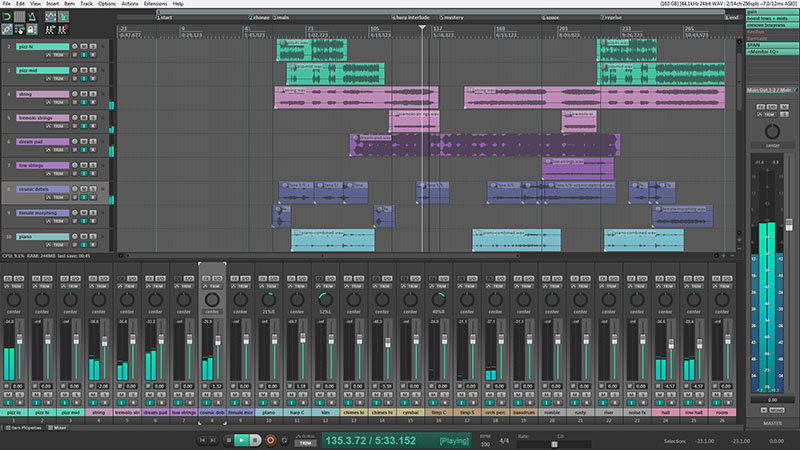
Renoise
| Version | 3.1.0 |
| Executable | 26 MiB |
| DLL files | 1.3 MiB |
| Resources | 19 MiB |
| Library (presets, samples) | 131 MiB |
| Total install size | 195 MiB |
Renoise is probably the best cross-platform modern music tracker in existence today. It runs on Windows, OS X and Linux and it has a completely custom single-window UI. Everything is custom drawn, including the menus, dialogs, the file browser and so on. The graphics backend uses DirectX on Windows, OpenGL on OS X and presumably X directly on Linux. The UI is non-scalable and non-skinnable, the fonts are bitmap based (I think) and most of the drawing seems to be simple blitting. They also must have developed some custom graphics routines for the anti-aliased cross-platform drawing of dynamic UI elements (e.g. the waveform and envelope displays). The UI seems to be pixel-identical across platforms.
Renoise is closed source, so unfortunately I could not inspect how they accomplished all this, but very likely they had to come up with their own UI and graphics wrappers to maintain a single codebase for all three platforms.
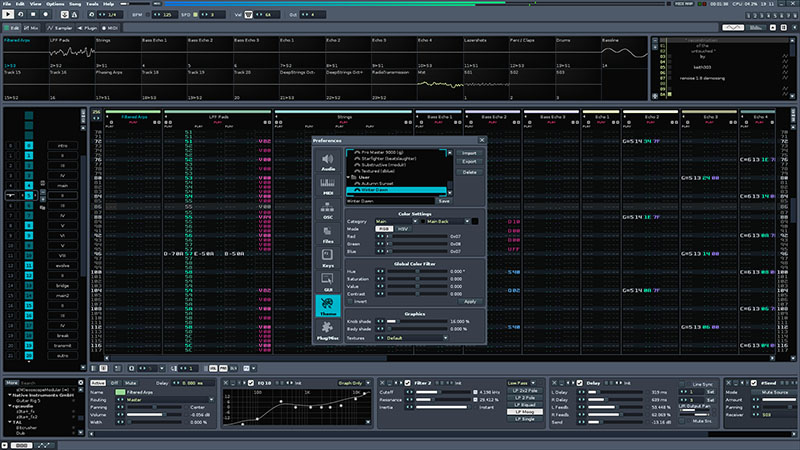
Tracktion
| Version | 7.1.1 |
| Main executable | 57 MiB |
| DLL files | 2.3 MiB |
| Total install size | 60 MiB |
Tracktion is another cross-platform DAW targeting the Windows, Mac OS X and Linux platforms. Like in the case of Renoise, the single-window GUI of Tracktion is fully custom drawn, but what sets it apart from the former is that the drawing here is much more dynamic: instead of having mostly fixed-size UI elements, all widgets in Tracktion shrink and enlarge as their respective containers change in size.
Tracktion is written in C++ and uses the JUCE library for all cross-platform duties (again, written by the same single person responsible for all Tracktion development). JUCE supports anti-aliased vector graphics and text output through a number of wrapper classes that can use either JUCE’s internal software rasterizer or one of the supported platform specific graphics APIs as their backend (e.g. Direct2D and DirectWrite on Windows, CoreGraphics on OS X). All platform-specific event and window handling is abstracted away in a similar fashion.
The JUCE library is available for free for non-commercial open-source projects, but a commercial license will make the wallets of enterprising developers exactly $999 lighter.
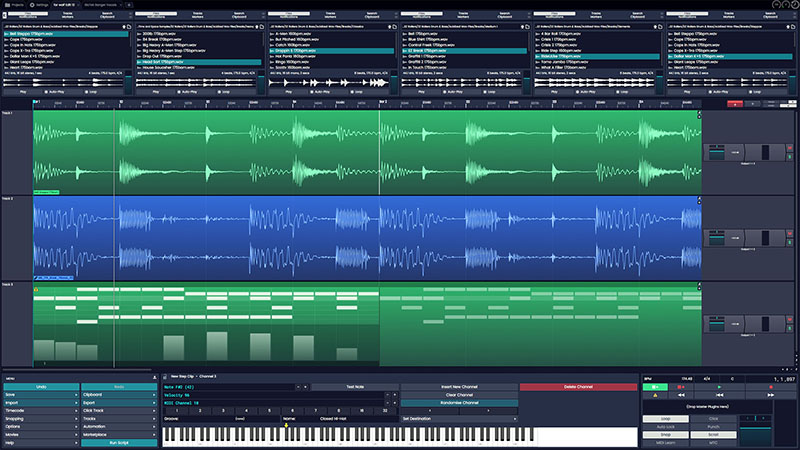
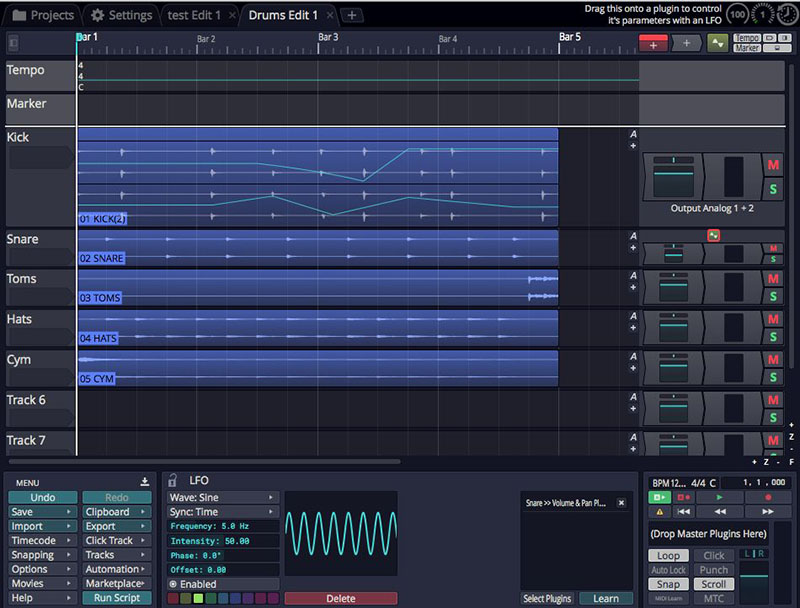
Blender
| Version | 2.77 |
| Main executable | 94 MiB |
| DLL files | 29 MiB |
| Python | 53 MiB |
| Data | 49 MiB |
| Scripts | 34 MiB |
| Total install size | 305 MiB |
Blender doesn’t need much introduction, being the most well-known open-source 3D package for Windows, OS X and Linux. On the UI front, it uses a completely different approach to all the previous examples: the contents of the whole window, including the render view and the user interface, are drawn using pure OpenGL. There’s no fallback to any other rendering backends—Blender simply doesn’t run on systems without OpenGL support.
This makes certain interesting things possible, such as semi-transparent UI elements overlaid on top of OpenGL views, as shown on the screenshot below. The UI is fully scalable (including font sizes) and quite dynamic, and it’s also worth noting that it’s fully defined in the form of Python scripts (hence the bundled Python interpreter).
Displaying text elements is accomplished via glyphs pre-rendered into texture atlases with FreeType (possibly a modified version). One of the biggest weaknesses of OpenGL based UI drawing is the difficulty of rendering crisp and clear looking anti-aliased text, as evidenced by these notes on the Blender developer wiki.
In theory, it would be possible to re-use Blender’s cross-platform UI layer written in C in other applications, but because its tight coupling to Blender’s internals, no one has been able to do so yet in practice.
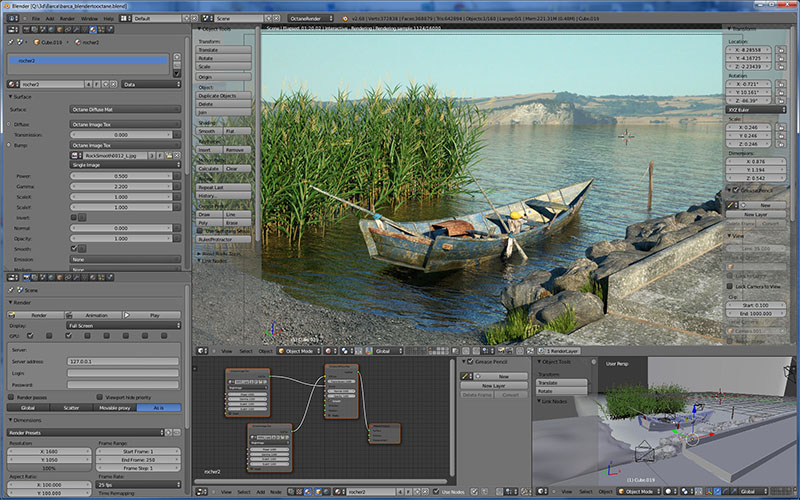
Cinema 4D
I cannot provide any detailed info on Cinema 4D because I’m not using it personally (and I couldn’t bring myself to download the 3 GB demo installer just to check the executable size…) It’s still worthwhile to include it in this discussion because a) the UI looks good, b) most other commercial 3D packages follow a very similar approach.
We can deduce a lot from the screenshot below. First, note the image dimensions: 2880-by-1714. The display resolution of a 15" 2015 Retina MacBook Pro is 2880-by-1800, so this is a screenshot of the Mac version. Also note that at 1:1 magnification the text and the large icons are very crisp looking, but the rest of the UI, including the render view, is made up of double-sized (2x2) pixels—a tell-tale sign of partial Retina display support. Apparently, they’re using native text rendering, taking advantage of high-resolution displays whenever possible, but the rest of the UI probably consists of simple bitmaps only. The render preview is drawn using 2x2 pixels too, most likely due to performance reasons. Having a look at some random Windows screenshots further validates this assumption; on those images the text looks very much like a default 9px Tahoma UI font rendered with ClearType.
It seems that similarly to REAPER, Cinema 4D uses native graphics and text rendering to draw its UI, probably via some custom wrapper libraries.
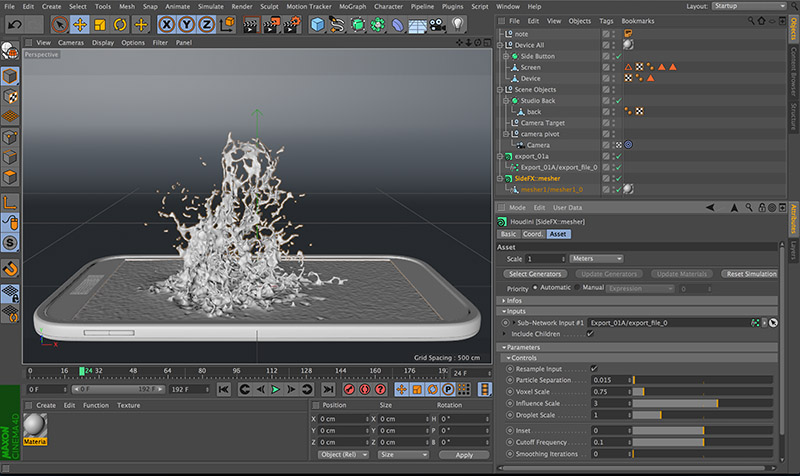
NodeBox3
| Version | 3.0.44 |
| Main executable (JAR) | 22 MiB |
| Libraries (ffmpeg) | 12 MiB |
| Java runtime | 172 MiB |
| Python interpreter | 4.4 MiB |
| Examples | 8.3 MiB |
| Total install size | 220 MiB |
NodeBox3 is a quite interesting open-source generative graphics tool that runs on Windows, Mac OS X and Linux. In contrast to the previously discussed applications, NodeBox is not a native executable written in C++ but a Java program. The custom-looking UI is built with the help of Swing (that’s the standard Java GUI library), as it can be seen here.
Relying on the cross-platform Java runtime is certainly very convenient from the developers' perspective, but is not without some serious drawbacks. First of all, the whole Java runtime environment has to be bundled with the application (at least on Windows and OS X), which accounts to a whopping 172 MiB in this concrete example (that’s 78% of the total install size!). Interface redraws are much more sluggish compared to native applications like REAPER and Renoise, startup times are generally slow, and Java applications overall tend to be memory hogs. All these things are mostly non-issues for long-running server-side applications (the most natural habitat of Java bytecode), but they make the platform a less than ideal choice for high-performance desktop applications.
In conclusion, while Java is certainly not the most terrible choice for a cross-platform GUI app, it’s far from being the greatest either. For some less demanding software, such as NodeBox, it may be an OK solution, but I’m really averse to the idea of a DAW written in Java where every little bit of performance counts.
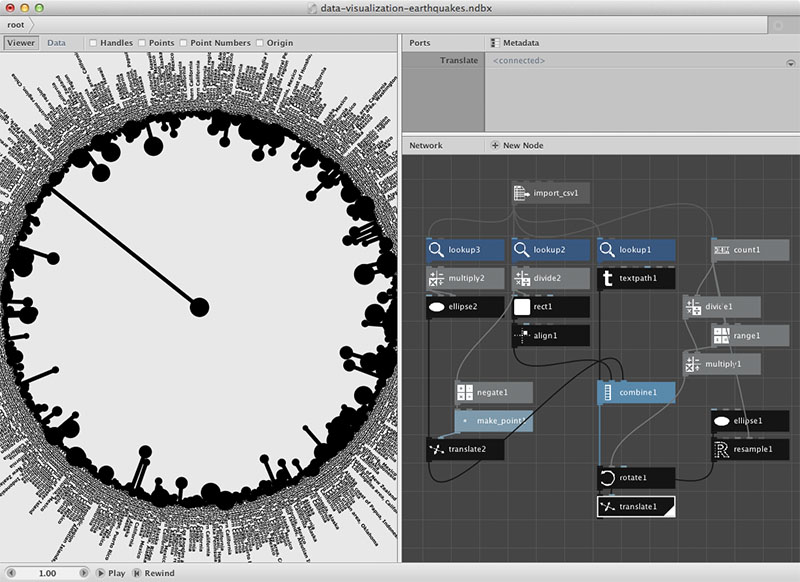
Light Table
| Version | 0.8.1 |
| Main executable | 51 MiB |
| Electron framework | 42 MiB |
| Resources | 33 MiB |
| Total install size | 129 MiB |
Light Table is a next generation code editor that connects you to your creation with instant feedback.
This quote was taken from the project’s GitHub page and I think it sums up this novel IDE pretty well. Light Table is available for Windows, Mac OS X and (can you guess?) Linux; it achieves cross-platform compatibility by leveraging the Electron framework. In basic terms, Electron consists of a Chromium browser and Node.js, so developers can use hipster technologies like HTML, CSS and JavaScript to build their cross-platform desktop applications. Light Table is actually written in ClojureScript, which transpiles to JavaScript. This makes perfect sense as the IDE was originally intended to be a programming environment for Clojure only.
I don’t have any personal experience using Light Table, and while I think the application itself is a great idea, I cannot say much positive about the underlying Electron framework. Light Table seems to have been plagued by serious performance issues which were the main reason for them having to migrate from node-webkit (their previous framework, now known as NW.js) to Electron at the end of 2015 (see here). That’s a very severe drawback of such Web-technologies-on-the-desktop style of frameworks; they introduce too many layers of abstraction over OS provided functionalities that often result in serious performance bottlenecks. And when things don’t quite work as expected, you can’t do much about it—short of maybe just switching to a different framework as a last attempt. (Of course, this problem can happen with OS-native libraries as well, but in practice it is much less of a problem, as OS APIs are generally several orders of magnitude more robust and performant, and there’s much more leeway for workarounds on the OS level if anything does not quite work as expected).
Now as I think about it, the only reasons for the existence of such frameworks is the allure of quick time to market, the luxury of being able to trade development speed for program efficiency (because on contemporary hardware you can be really wasteful with resources in many problem domains and the resulting program will still remain mostly functional), and the vast armies of newskool web developers who grew up on JavaScript and the DOM. But the trade-offs involved are quite severe: performance, memory consumption, installation sizes and OS integration will suffer, and long-term maintenance will be a nightmare. Despite all the drawbacks, I can see this approach work acceptably well in some specific circumstances (non-demanding applications aimed at a not too picky—and hopefully non-technical—audience). But if you care about your users and cannot afford to be grossly inefficient, just stay away from web technologies on the desktop. You don’t want to build a castle on sand.
I think of it as my duty to point out that the Electron framework carries a terrible potential for misuse when fallen into the wrong hands. The Monu OS X only process monitoring menu bar application built using Electron weighs no less than 189 MiB on disk! Yes, you read that right: a heavyweight cross-platform framework featuring a complete built-in browser engine was used to create a menu bar widget for a single platform! No disrespect to the program’s author, I’m sure he had the best intentions and he’s a nice person and all (even if he is clearly somewhat misguided in the practical execution of his ideas), but who would seriously entertain even just the thought that a 189 MiB menu bar app was going to be an okay thing to do, honestly?
Executive summary
By analysing the commonalities of the apps showcased so far, we can see a few interesting patterns emerging. For event and window handling, they all must have used the host OS (or host platform, in the case of managed applications) in some way, so nothing too much exciting going on there. Regarding the cross-platform graphics problem, each one of them must have implemented some kind of variation on one of the following basic approaches:
- Make use of the graphics and text libraries provided by the host OS
- Use a software renderer for all graphics
- Use OpenGL for all graphics
- Use a cross-platform environment (e.g. Electron or Java) to abstract away all platform-specific stuff
Here’s my expert analysis on the pros and cons of each method:
Using native graphics APIs (1) is probably the least pixel-identical approach across platforms (especially text rendering can look wildly different on different operating systems), but this is rarely a problem in practice for most applications. In fact, platform-native text rendering can be seen as a feature rather than a drawback—think of Retina displays, or how hardcore Windows users typically prefer ClearType over the unhinted OS X style text rendering, and vice versa. While there might be some minor differences in the way different platforms render anti-aliased vector graphics natively, those differences are generally negligible for most use-cases (and for most users not suffering from some chronically acute case of OCD). Another important point to note is that OS native graphics usually takes advantage of the GPU on most major platforms, so we get hardware acceleration for free.
Only a software renderer (2) guarantees to yield 100% identical results across all platforms down to the pixel level (except if you’re only blitting pre-stored pixel images), but it’s a lot of work and it will be potentially much slower than the often GPU-accelerated native graphics API (unless you’re a graphics guru and know exactly what you’re doing). Overall, I think it’s a wasted effort, unless you have some special requirements to do the rendering in a very specific, pixel-exact way across all supported platforms. But yes, in the past people had to come up with their own rasterizers if they were not happy with the crappy aliased graphics provided by the Windows GDI and such.
OpenGL (3) initially seems to be a very good fit for cross-platform graphics duties; after all, it’s hard to get hold of hardware nowadays (even second-hand!) that does not have support for it. But driver support can be an issue; there’s some rumours, for example, that Intel OpenGL drivers are pretty shit in that regard. The other thing that can throw the spanner in the works is font rendering. There are lots of different approaches to it, and while some might be perfectly fine for a particular application, generally it’s a major pain in the ass. Just have a look at this post if you don’t believe me to see what kind of quite absurd hoops these poor Swedes had to jump through just to display some animated text. Oh, and you’d also need to come up with your own tesselator engine that can construct nice smooth Bézier curves out of little triangles and so on. Compared to the native graphics approach, this is a lot of work, more or less on par with writing your own software rasterizer. Again, the native graphics libraries are already doing the tesselation stuff (and lots more) for you for free if a GPU is present and fall back to software rendering otherwise. But for games and similar full-screen applications where you really want to superimpose the UI on top of the 3D view, you really don’t have much other choice (and a naive IMGUI approach might actually be a very good fit).
Cross-platform application development environments (4) might be okay (but not great) for simpler, less demanding stuff. But when performance is a concern, they are definitely not the way to go. The total install size will also suffer (to be very polite and ladylike about it). Overall, apart from making life easier for certain types of developers (primarily the ones who enjoy hacking Java + Swing and the JavaScript-for-all-the-things webdev folks), this approach has a lot of drawbacks. I also don’t think that shoehorning web development technologies—which technically don’t provide any advantages over more traditional approaches—into desktop applications is a very sound idea either. So for any serious work, avoid.
So what the hell to do?
…apart from writing a semi-useless blog post/rant about this utter fiasco, that is. Looks like that an easy to use, well-performing and non-bloated library to help with cross-platform UI and graphics duties in the age of Mars rovers, Go world-champion beating AI constructs and genetically modified carrots that will kill you in your sleep is just too much ask for.
The computer says no.
JUCE is probably the one that comes closest, but it’s C++, semi-bloated and not free for commercial purposes. There’s WDL too, but that’s still C++ and looks rather disgusting. Also, hacking C++ in my spare time is very far from my idea of fun. If there would be really no other option, I guess I’d just stop coding altogether and find a more relaxing hobby. Like dirt car racing, wrestling with alligators, or disarming bombs or something.
Other than JUCE (and maybe WDL), we’d have to roll your own, plain and simple. And that’s exactly what many people have been doing, apparently, and that’s what I’m gonna do too. To help decide how to accomplish this lofty goal, the below table summarises my ratings of the various approaches outlined previously. I made this really very scientific: one plus means a given feature is somewhat enjoyable to implement, one minus means it slightly sucks, et cetera—you get the picture.
So let’s see (Java and web technologies are disqualified on purpose for I really think they have no place on the desktop):
| Software renderer | Native wrapper | OpenGL | |
|---|---|---|---|
| Windowing | native OS API - | native OS API - | GLFW (or similar) + |
| Input handling | native input handling - | native input handling - | GLFW (or similar) + |
| Graphics | custom rasterizer - - - | native graphics API + | custom tesselator - - - |
| Text | FreeType - - | native text API + | FreeType (w/ font atlas) - - - |
| Total | - - - - - - - | 0 | - - - - |
And the final verdict: the native wrapper method is the lucky winner (read: it sucks the least, compared to the major suckage involved with the other two approaches).
Phew.
Final words
Well, I really wanted to avoid this, but I simply must acknowledge the fact that to produce a good quality custom cross-platform GUI in 2016, there’s really no substitute to rolling up your sleeves and developing your own platform-agnostic UI and graphics libraries.
Oh well, I only wanted to display a few buttons and maybe push some pixels, but fuck all that, let’s write a whole cross-platform GUI library in Nim!
Time to get serious!

The last three new age wisdoms courtesy of the Wisdom of Chopra bullshit generator. ↩︎
Note the nested parentheses—a true tell-tale sign of my latent LISP tendencies! ↩︎

Comments
comments powered by Disqus